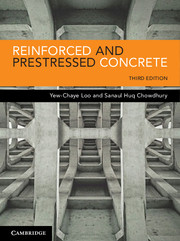Book contents
- Frontmatter
- Deidcation
- Contents
- Preface to the first edition
- Preface to the second edition
- Preface to the third edition
- Acknowledgements
- Notation
- Acronyms and abbreviations
- Part 1 Reinforced concrete
- 1 Introduction
- 2 Design properties of materials
- 3 Analysis and design of rectangular beams for bending
- 4 T-beams and irregular-shaped sections
- 5 Deflection of beams and crack control
- 6 Ultimate strength design for shear
- 7 Ultimate strength design for torsion
- 8 Bond and stress development
- 9 Slabs
- 10 Columns
- 11 Walls
- 12 Footings, pile caps and retaining walls
- 13 Strut-and-tie modelling of concrete structures
- Part 2 Prestressed concrete
- Appendix A Elastic neutral axis
- Appendix B Critical shear perimeter
- Appendix C Australian Standard precast prestressed concrete bridge girder sections
- References
- Index
13 - Strut-and-tie modelling of concrete structures
from Part 1 - Reinforced concrete
Published online by Cambridge University Press: 12 December 2018
- Frontmatter
- Deidcation
- Contents
- Preface to the first edition
- Preface to the second edition
- Preface to the third edition
- Acknowledgements
- Notation
- Acronyms and abbreviations
- Part 1 Reinforced concrete
- 1 Introduction
- 2 Design properties of materials
- 3 Analysis and design of rectangular beams for bending
- 4 T-beams and irregular-shaped sections
- 5 Deflection of beams and crack control
- 6 Ultimate strength design for shear
- 7 Ultimate strength design for torsion
- 8 Bond and stress development
- 9 Slabs
- 10 Columns
- 11 Walls
- 12 Footings, pile caps and retaining walls
- 13 Strut-and-tie modelling of concrete structures
- Part 2 Prestressed concrete
- Appendix A Elastic neutral axis
- Appendix B Critical shear perimeter
- Appendix C Australian Standard precast prestressed concrete bridge girder sections
- References
- Index
Summary
Introduction
‘Strut-and-tie modelling’ is described in Section 7 of AS 3600–2009 (the Standard). Since the original issue of AS 3600 (1988), the current Standard is the first update in which a separate section is devoted to this type of modelling. This chapter serves to complement Section 7 of the Standard.
Figure 13.l(1) shows some typical reinforced and prestressed concrete structures and elements. In terms of stress distribution characteristics in response to external loads, each structure or element can be divided into the so-called ‘B’ and ‘D’ regions (Schlaich, Schafer and Jennewein 1987; Schlaich and Schafer 1991). In general, B regions are dominated by bending and D regions (the ‘distributed’ or discontinuous regions) are dominated by nonflexural stresses.
The analysis and design of various B regions have been extensively explored in most chapters of this book. That the strength behaviour of B (bending) regions can be accurately determined or designed for, using explicit formulas or well-prescribed analytical procedures, is beyond doubt. However, the same cannot be said of the behaviour of the D regions. For these, the analysis or design in general requires rather crude empirical formulas or, alternatively, the aid of sophisticated computer-based numerical procedures, such as the finite element method. The strut-and-tie modelling technique, on the other hand, can provide a direct design process for many types of D region.
The fundamental concepts of the strut-and-tie model (STM) and some recent developments of the technique are discussed in this chapter, typical models taking the form of statically determinate truss systems are illustrated, and the Standard's specifications for various types of struts, ties and ‘nodes’ are also described.
Fundamentals
A typical deep beam under a single concentrated load (P) at midspan is illustrated in Figure 13.2(1)a. The zones between the external load and the two reactions may be taken as a D region. Under the load P and the reactions P/2, the compressive and tensile stress distributions, as represented by the stress trajectories, are presented schematically in Figure 13.2(1)a. It is obvious that zones a–d–b–a and a–e–c–a are dominated by compressive stresses, whereas zone f–g–h is dominated by tensile stresses. As the span–depth ratio L/h becomes smaller, the compressive and tensile stress fields (zones) would become more and more distinctive.
Information
- Type
- Chapter
- Information
- Reinforced and Prestressed Concrete , pp. 377 - 400Publisher: Cambridge University PressPrint publication year: 2018
